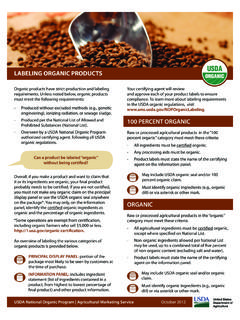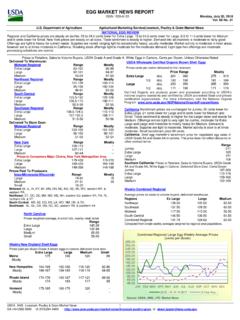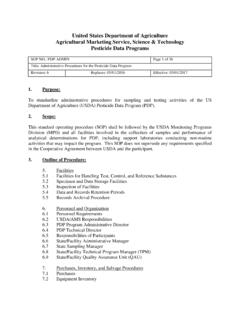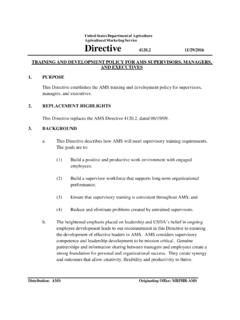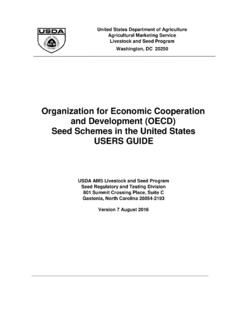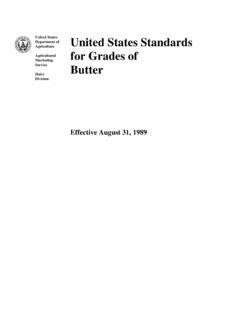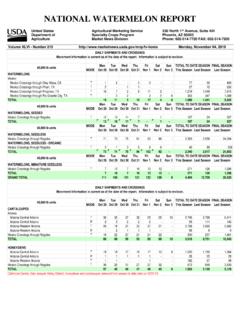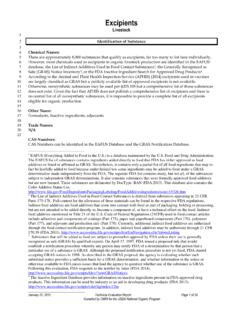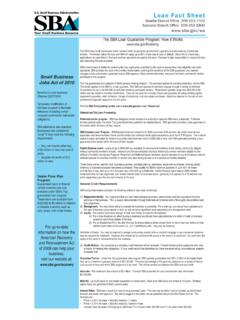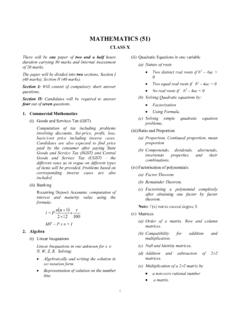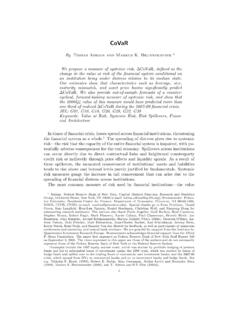Transcription of Hemp Sampling Guidelines Issued January 15, 2021
1 Sampling Guidelines for Hemp Domestic Hemp Production Program Issued January 15, 2021 Purpose: 1. Standard and Performance-based Sampling Guidelines are specified for field and indoor Sampling of hemp. States and Tribes shall develop their own Sampling protocols in accordance with 2. Samples are taken to obtain specimens for the measurement of total tetrahydrocannabinol (THC) content, which determine whether the specimens are hemp or marijuana. The measurements are intended to be representative of the total THC content in a lot of hemp crop acreage as identified by the producer. Hemp producers may not harvest hemp prior to the hemp being sampled for THC concentration. Testing procedures are provided in a separate guidance document. Scope: 1. Samples collected under this procedure are acceptable for submission to a qualified testing laboratory for determination of total THC concentration in hemp.
2 After December 31, 2022, all laboratories testing hemp under the Domestic Hemp Production Program must be registered with the DEA in accordance with (a)(3)(iii)(H) and (g)(iii). 2. Since the THC content of hemp generally peaks as the plant ripens, the timing of when Sampling occurs is important to accurately measure total THC concentration and monitor compliance with the USDA hemp production program. Harvest shall be completed within 30 days from sample collection. 3. Samples shall be collected only by a trained Sampling agent. Sampling agents must be trained under applicable USDA, State, or Tribal training procedures. States and Tribes must maintain information, available to producers, about trained Sampling agents. Hemp producers may not act as Sampling agents. 4. It is the responsibility of the licensed producer to pay any fees associated with Sampling .
3 5. It is the responsibility of the Sampling agent to pay any fees associated with Sampling agent training or testing. Summary of Practice: 1. This practice provides procedures for entering a growing area and collecting the minimum number of plant specimens necessary to represent a homogeneous composition of the lot that is to be sampled. A trained Sampling agent enters a growing area, strategically examines the growing area, establishes an approach for navigating the growing area, and collects individual specimens of plants in order to obtain a representative sample of hemp in the designated lot. 2. Cuttings from each lot of hemp crop acreage, as identified by the producer, and submitted to and uniquely identified by the Farm Service Agency (FSA) per the requirements of the USDA hemp production program, shall be organized as composite samples.
4 The terminology used by FSA to denote land areas include terms like farm, tract, field, and subfield, which are equivalent to AMS s term lot. For the purposes of these procedures, a lot is a contiguous area in a field, greenhouse, or indoor growing structure containing the same variety or strain of cannabis throughout. In addition, lot refers to the batch of contiguous, homogeneous whole of a product being sold to a single buyer at a single time. The size of the Lot is determined by the producer in terms of farm location and field acreage and is to be reported as such to the FSA. Performance-Based Sampling Protocols: 1. States and Tribes may develop performance-based Sampling protocols. 2. Performance-based Sampling protocols may consider s eed certification processes, other process that identify varieties that have consistently resulted in compliant hemp plants, whether the producer is conducting research on hemp at an institution of higher learning or that is funded by a Federal, State, or Tribal government, whether a producer has consistently produced compliant hemp plants over an extended period of time, and other similar factors.
5 3. Performance-based Sampling protocols may consider alternative requirements for operations that grow immature cannabis that does not reach the flowering stage. These facilities may grow seedlings, clones, microgreens, or other non-flowering cannabis, as determined by the State or Tribe. 4. A performance-based Sampling protocol must have the potential to ensure, at a confidence level of 95 percent, that the cannabis plants will not test above the acceptable hemp THC level of percent on a dry weight basis. 5. Regardless of the specific performance-based Sampling requirements developed under a State or Tribal plan, all samples must be collected from the flowering tops of the plant by cutting the top five to eight inches from the main stem (that includes the leaves and flowers), terminal bud (that occurs at the end of a stem), or central cola (cut stem that could develop into a bud) of the flowering top of the plant.
6 6. States and Tribes are required to include performance-based Sampling protocols in the plan submitted to USDA for approval if they decide to use this methodology. Standard Sampling Protocols: 1. The standard Sampling method must be used by all producers, except for producers operating under a State or Tribal plan that includes a performance-based Sampling requirement. 2. The standard Sampling protocol ensures, at a confidence level of 95 percent, that no more than one percent of the plants in each lot would exceed the acceptable hemp THC level and ensures that a collected sample represents a homogeneous composition of the lot. 3. Every lot and every producer must be sampled and tested. 4. All samples must be collected from the flowering tops of the plant by cutting the top five to eight inches from the main stem (that includes the leaves and flowers), terminal bud (that occurs at the end of a stem), or central cola (cut stem that could develop into a bud) of the flowering top of the plant.
7 5. All producers licensed directly by USDA are subject to these requirements. Equipment and Supplies: 1. Garden pruners/shears (Cleaned prior to and following each composite sample. Some examples of appropriate cleaning agents and supplies to use on garden pruners/shears are bleach, rubbing alcohol, steel wool, and/or sandpaper.) 2. Sample bags, paper. The size of the bags will depend upon the number of clippings collected per lot. The bags should be made from material known to be free from THC. 3. Security tape 4. Permanent markers 5. Sample collection forms 6. GPS Unit of lot being sampled 7. Disposable gloves Nitrile 8. Ladder Sampling Guidelines : 1. The licensee or designated employee should be present throughout the Sampling process, if possible. 2. Surveillance of the growing area. The Sampling agent should estimate the average height, appearance, approximate density, condition of the plants, and degree of maturity of the inflorescences (flowers/buds).
8 The Sampling agent should visually establish the homogeneity of the stand to establish that the growing area is of like variety. of Sampling : Within 30 days prior to the anticipated harvest of a designated hemp lot, an approved Sampling agent, State or Tribally designated person or Federal, State, local, or Tribal law enforcement agency shall collect representative samples from such cannabis plants for THC concentration level testing. 4. Field Sampling : The licensee or designated employee should accompany the Sampling agent throughout the Sampling process, if possible. 5. Surveillance of the growing area. The Sampling agent should verify the GPS coordinates of the growing area as compared with the GPS coordinates submitted by the licensee to USDA. The Sampling agent should estimate the average height, appearance, approximate density, condition of the plants, and degree of maturity of the inflorescences (flowers/buds).
9 The Sampling agent should visually establish the homogeneity of the stand to establish that the growing area is of like variety. 6. Time of Sampling : Within 30 days prior to the anticipated harvest of a lot a Sampling agent should collect representative samples from such a lot for THC concentration level testing. 7. Field Sampling : For purposes of determining the number of individual plants to select for Sampling , the size of the growing area should be considered. For Sampling purposes, samples from separate lots must be kept separate and not be comingled. For lots of less than one acre, including greenhouses, select a minimum of 1 plant, then take a cutting from the plant to form a sample. For lots of 1 to 10 acres, including greenhouses, follow the chart in example 2 below, take cuttings of each plant, then combine to form a composite sample.
10 For growing areas larger than ten (10) acres, including greenhouses, the number of plants that should be selected to form a composite sample is based upon the Codex Alimentarius Recommended Methods of Sampling for the Determination of Pesticide Residues for Compliance with MRLS CAC/GL 33-1999. The sample size is estimated in a two-step process. The first step is to estimate the number of primary plants to be sampled. The second step is to adjust the estimate of primary plants by the acreage under cultivation. The initial number of primary plants is estimated using: where p is the confidence level to detect hemp plants testing above the acceptable THC threshold and i is the proportion of hemp plants having THC content above the acceptable threshold. The values for i are based on past experience in the same or similar growing areas, and should be consistent with the requirements currently in the Final Rule.
